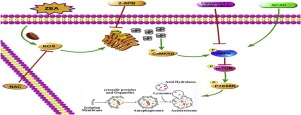当前位置:
X-MOL 学术
›
Toxicol. Lett.
›
论文详情
Our official English website, www.x-mol.net, welcomes your feedback! (Note: you will need to create a separate account there.)
ZEA-induced autophagy in TM4 cells was mediated by the release of Ca2+ activates CaMKKβ-AMPK signaling pathway in the endoplasmic reticulum
Toxicology Letters ( IF 3.5 ) Pub Date : 2020-05-01 , DOI: 10.1016/j.toxlet.2020.01.010 Nannan Feng 1 , Bingjie Wang 2 , Peirong Cai 2 , Wanglong Zheng 2 , Hui Zou 2 , Jianhong Gu 2 , Yan Yuan 2 , Xuezhong Liu 2 , ZongPing Liu 1 , Jianchun Bian 1
Toxicology Letters ( IF 3.5 ) Pub Date : 2020-05-01 , DOI: 10.1016/j.toxlet.2020.01.010 Nannan Feng 1 , Bingjie Wang 2 , Peirong Cai 2 , Wanglong Zheng 2 , Hui Zou 2 , Jianhong Gu 2 , Yan Yuan 2 , Xuezhong Liu 2 , ZongPing Liu 1 , Jianchun Bian 1
Affiliation

|
Zearalenone (ZEA) is a prevalent non-steroidal estrogenic mycotoxin produced mainly by Fusarium contamination. Our previous study showed that ZEA induces the autophagy of Sertoli cells (SCs). However, the underlying mechanisms are still unknown. Several studies have indicated that the increasing level of cytoplasmic Ca2+ could induce autophagy through CaMKKβ and AMPK pathways. Thus in order to investigate the potential mechanism underlying ZEA-induced autophagy, the activity of calmodulin-dependent kinase kinase β(CaMKKβ)and AMP-activated protein kinase (AMPK) signaling pathway in ZEA-infected TM4 cells was studied. In the present study, ZEA activated the CaMKKβ and AMPK signaling pathways. The AMPK inhibitor and activator significantly inhibited and stimulated the effect of ZEA on AMPK, the transformation from LC3I to LC3II, and the distribution of LC3 dots. In addition, cytosolic calcium (Ca2+) was increased gradually with the concentration of ZEA. After treatment of ZEA-infected cells with 1, 2-bis (2-aminophenoxy) ethane-N, N, N', N'- tetraacetic acid- tetraac etoxymethyl ester (BAPTA-AM) and 2-aminoethyl diphenylborinate (2-APB), the intracellular concentration of Ca2+ reduced significantly. Also, the activities of CaMKKβ and AMPK and subsequent autophagy decreased. Moreover, the antioxidant NAC significantly decreased activities of AMPK and autophagy -related protein. Therefore, it can be speculated that ROS- mediated ER-stress induced by ZEA activates AMPK via Ca2+-CaMKKβ leading to autophagy in TM4 cells.
中文翻译:

TM4细胞中ZEA诱导的自噬是由Ca2+的释放介导的,激活内质网中的CaMKKβ-AMPK信号通路
玉米赤霉烯酮 (ZEA) 是一种流行的非甾体雌激素霉菌毒素,主要由镰刀菌污染产生。我们之前的研究表明,ZEA 诱导支持细胞 (SCs) 的自噬。然而,潜在的机制仍然未知。一些研究表明,细胞质 Ca2+ 水平的增加可以通过 CaMKKβ 和 AMPK 途径诱导自噬。因此,为了研究 ZEA 诱导自噬的潜在机制,研究了 ZEA 感染的 TM4 细胞中钙调蛋白依赖性激酶激酶 β(CaMKKβ)和 AMP 活化蛋白激酶(AMPK)信号通路的活性。在本研究中,ZEA 激活了 CaMKKβ 和 AMPK 信号通路。AMPK 抑制剂和激活剂显着抑制和刺激了 ZEA 对 AMPK 的作用,即从 LC3I 到 LC3II 的转化,以及LC3点的分布。此外,细胞溶质钙 (Ca2+) 随着 ZEA 的浓度逐渐增加。用 1, 2-双 (2-氨基苯氧基) 乙烷-N, N, N', N'-四乙酸-四乙酸乙氧基甲酯 (BAPTA-AM) 和 2-氨基乙基二苯基硼酸酯 (2-APB) 处理 ZEA 感染的细胞后),细胞内Ca2+浓度显着降低。此外,CaMKKβ 和 AMPK 的活性以及随后的自噬降低。此外,抗氧化剂 NAC 显着降低了 AMPK 和自噬相关蛋白的活性。因此,可以推测由 ZEA 诱导的 ROS 介导的 ER 应激通过 Ca2+-CaMKKβ 激活 AMPK,导致 TM4 细胞中的自噬。2-双(2-氨基苯氧基)乙烷-N、N、N'、N'-四乙酸-四乙酸乙氧基甲酯(BAPTA-AM)和2-氨基乙基二苯基硼酸酯(2-APB),细胞内Ca2+浓度显着降低。此外,CaMKKβ 和 AMPK 的活性以及随后的自噬降低。此外,抗氧化剂 NAC 显着降低了 AMPK 和自噬相关蛋白的活性。因此,可以推测由 ZEA 诱导的 ROS 介导的 ER 应激通过 Ca2+-CaMKKβ 激活 AMPK,导致 TM4 细胞中的自噬。2-双(2-氨基苯氧基)乙烷-N、N、N'、N'-四乙酸-四乙酸乙氧基甲酯(BAPTA-AM)和2-氨基乙基二苯基硼酸酯(2-APB),细胞内Ca2+浓度显着降低。此外,CaMKKβ 和 AMPK 的活性以及随后的自噬降低。此外,抗氧化剂 NAC 显着降低了 AMPK 和自噬相关蛋白的活性。因此,可以推测由 ZEA 诱导的 ROS 介导的 ER 应激通过 Ca2+-CaMKKβ 激活 AMPK,导致 TM4 细胞中的自噬。抗氧化剂 NAC 显着降低 AMPK 和自噬相关蛋白的活性。因此,可以推测由 ZEA 诱导的 ROS 介导的 ER 应激通过 Ca2+-CaMKKβ 激活 AMPK,导致 TM4 细胞中的自噬。抗氧化剂 NAC 显着降低 AMPK 和自噬相关蛋白的活性。因此,可以推测由 ZEA 诱导的 ROS 介导的 ER 应激通过 Ca2+-CaMKKβ 激活 AMPK,导致 TM4 细胞中的自噬。
更新日期:2020-05-01
中文翻译:

TM4细胞中ZEA诱导的自噬是由Ca2+的释放介导的,激活内质网中的CaMKKβ-AMPK信号通路
玉米赤霉烯酮 (ZEA) 是一种流行的非甾体雌激素霉菌毒素,主要由镰刀菌污染产生。我们之前的研究表明,ZEA 诱导支持细胞 (SCs) 的自噬。然而,潜在的机制仍然未知。一些研究表明,细胞质 Ca2+ 水平的增加可以通过 CaMKKβ 和 AMPK 途径诱导自噬。因此,为了研究 ZEA 诱导自噬的潜在机制,研究了 ZEA 感染的 TM4 细胞中钙调蛋白依赖性激酶激酶 β(CaMKKβ)和 AMP 活化蛋白激酶(AMPK)信号通路的活性。在本研究中,ZEA 激活了 CaMKKβ 和 AMPK 信号通路。AMPK 抑制剂和激活剂显着抑制和刺激了 ZEA 对 AMPK 的作用,即从 LC3I 到 LC3II 的转化,以及LC3点的分布。此外,细胞溶质钙 (Ca2+) 随着 ZEA 的浓度逐渐增加。用 1, 2-双 (2-氨基苯氧基) 乙烷-N, N, N', N'-四乙酸-四乙酸乙氧基甲酯 (BAPTA-AM) 和 2-氨基乙基二苯基硼酸酯 (2-APB) 处理 ZEA 感染的细胞后),细胞内Ca2+浓度显着降低。此外,CaMKKβ 和 AMPK 的活性以及随后的自噬降低。此外,抗氧化剂 NAC 显着降低了 AMPK 和自噬相关蛋白的活性。因此,可以推测由 ZEA 诱导的 ROS 介导的 ER 应激通过 Ca2+-CaMKKβ 激活 AMPK,导致 TM4 细胞中的自噬。2-双(2-氨基苯氧基)乙烷-N、N、N'、N'-四乙酸-四乙酸乙氧基甲酯(BAPTA-AM)和2-氨基乙基二苯基硼酸酯(2-APB),细胞内Ca2+浓度显着降低。此外,CaMKKβ 和 AMPK 的活性以及随后的自噬降低。此外,抗氧化剂 NAC 显着降低了 AMPK 和自噬相关蛋白的活性。因此,可以推测由 ZEA 诱导的 ROS 介导的 ER 应激通过 Ca2+-CaMKKβ 激活 AMPK,导致 TM4 细胞中的自噬。2-双(2-氨基苯氧基)乙烷-N、N、N'、N'-四乙酸-四乙酸乙氧基甲酯(BAPTA-AM)和2-氨基乙基二苯基硼酸酯(2-APB),细胞内Ca2+浓度显着降低。此外,CaMKKβ 和 AMPK 的活性以及随后的自噬降低。此外,抗氧化剂 NAC 显着降低了 AMPK 和自噬相关蛋白的活性。因此,可以推测由 ZEA 诱导的 ROS 介导的 ER 应激通过 Ca2+-CaMKKβ 激活 AMPK,导致 TM4 细胞中的自噬。抗氧化剂 NAC 显着降低 AMPK 和自噬相关蛋白的活性。因此,可以推测由 ZEA 诱导的 ROS 介导的 ER 应激通过 Ca2+-CaMKKβ 激活 AMPK,导致 TM4 细胞中的自噬。抗氧化剂 NAC 显着降低 AMPK 和自噬相关蛋白的活性。因此,可以推测由 ZEA 诱导的 ROS 介导的 ER 应激通过 Ca2+-CaMKKβ 激活 AMPK,导致 TM4 细胞中的自噬。



























 京公网安备 11010802027423号
京公网安备 11010802027423号